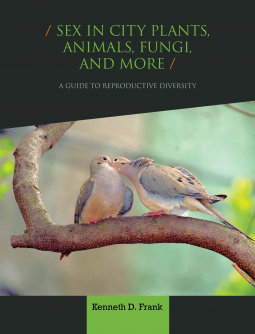
Sex in City Plants, Animals, Fungi, and More
A Guide to Reproductive Diversity
by Kenneth D. Frank
This title was previously available on NetGalley and is now archived.
Buy on Amazon
Buy on BN.com
Buy on Bookshop.org
*This page contains affiliate links, so we may earn a small commission when you make a purchase through links on our site at no additional cost to you.
Send NetGalley books directly to your Kindle or Kindle app
1
To read on a Kindle or Kindle app, please add kindle@netgalley.com as an approved email address to receive files in your Amazon account. Click here for step-by-step instructions.
2
Also find your Kindle email address within your Amazon account, and enter it here.
Pub Date Apr 19 2022 | Archive Date Jul 13 2022
Talking about this book? Use #SexinCityPlantsAnimalsFungiandMore #NetGalley. More hashtag tips!
Description
Cities pose formidable obstacles to nonhuman life. Vast expanses of asphalt and concrete are inhospitable to plants and animals; traffic noise and artificial light disturb natural rhythms; sewage and pollutants imperil existence. Yet cities teem with life: In rowhouse neighborhoods, tiny flowers bloom from cracks in the sidewalk. White clover covers lawns, its seeds dispersed by shoes and birds. Moths flutter and spiders weave their webs near electric lights. Sparrows and squirrels feast on the scraps people leave behind. Pairs of red-tailed hawks nest on window ledges. How do wild plants and animals in urban areas find mates? How do they navigate the patchwork of habitats to reproduce while avoiding inbreeding? In what ways do built environments enable or inhibit mating?
This book explores the natural history of sex in urban bacteria, fungi, plants, and nonhuman animals. Kenneth D. Frank illuminates the reproductive behavior of scores of species. He examines topics such as breeding systems, sex determination, sex change, sexual conflict, sexual trauma, sexually transmitted disease, sexual mimicry, sexual cannibalism, aphrodisiacs, and lost sex. Frank offers a guide to urban reproductive diversity across a range of conditions, showing how understanding of sex and mating furthers the appreciation of biodiversity. He presents reproductive diversity as elegant but vulnerable, underscoring the consequences of human activity. Featuring compelling photographs of a multitude of life forms in their city habitats, this book provides a new lens on urban natural history.
This book explores the natural history of sex in urban bacteria, fungi, plants, and nonhuman animals. Kenneth D. Frank illuminates the reproductive behavior of scores of species. He examines topics such as breeding systems, sex determination, sex change, sexual conflict, sexual trauma, sexually transmitted disease, sexual mimicry, sexual cannibalism, aphrodisiacs, and lost sex. Frank offers a guide to urban reproductive diversity across a range of conditions, showing how understanding of sex and mating furthers the appreciation of biodiversity. He presents reproductive diversity as elegant but vulnerable, underscoring the consequences of human activity. Featuring compelling photographs of a multitude of life forms in their city habitats, this book provides a new lens on urban natural history.
Advance Praise
"Cities are renowned as hotspots of human diversity. This book demonstrates that although less well known, this is equally true of biodiversity. Here this is viewed through the unusual lens of reproductive diversity - the variety of means by which organisms perpetuate their lineages. It is a volume filled with insight, and lots of natural history nuggets, and is beautifully illustrated. I imagine that most readers will find ‘I didn’t know that’ moments throughout."
--Kevin J. Gaston, University of Exeter
Available Editions
| EDITION | Other Format |
| ISBN | 9780231206075 |
| PRICE | $36.00 (USD) |



